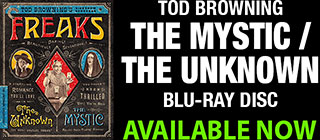Silent Era Home Page > Home Video > The Penalty

Reviews of silent film releases on home video.
Copyright © 1999-2024 by Carl Bennett
and the Silent Era Company.
All Rights Reserved. |
The Penalty
(1920) |
Lon Chaney’s first major starring role was in the Goldwyn production The Penalty (1920). And while Chaney’s cruel character is far from the hero of the film, he is the pivotal character. After the success of Chaney’s portrayal of a fake cripple in The Miracle Man (1919), this extremely challenging role of the mutilated crime king Blizzard was given to Chaney. One may ask: How was this gritty underworld film not made by the Lon Chaney-Tod Browning tandem? It certainly has prominent elements of a Chaney-Browning film: crime and cripples. But Chaney and Browning had made their first film together at the end of 1918 at Universal, however it wasn’t until Outside the Law (1920) that they had begun their successful series of uncompromised crime and shocker films. Instead, Chaney was ably directed by Wallace Worsley, who would helm a number of Chaney features including The Hunchback of Notre Dame (1923).
The film begins with a teenage boy who is the victim of an undefined accident. His legs are hastily amputated above the knee by an inexperienced doctor, young Dr. Ferris. Another doctor rebukes Ferris for his premature surgery. The boy overhears their exchange. Years later, the locale is San Francisco’s Barbary Coast. A female Federal agent, Rose, is sent undercover to discover Blizzard’s plans and to gather the evidence that is needed bust up his crime ring. Blizzard seeks to wreak his vengeance upon San Francisco and the doctor who mangled him as a boy, who is now a respected surgeon. Ferris’ daughter has chosen to be a sculpter rather than rush into a marriage with her father’s assistant, Dr. Allen. Blizzard manipulates himself into the position as Barbara’s model for a bust of Satan, her masterwork. In their conversation on art and amputees, Blizzard says, “When Satan fell from Heaven he looked for power in Hell.”
Meanwhile, Rose discovers a few suspicious but confounding bits of evidence. Rose’s communique to her supervisor is intercepted by a drug-addicted henchman. Her sleuthing efforts are further given away by a single hairpin, but Blizzard is held back from murdering her by her participation in his piano playing, something he cannot do without the help of Rose. Blizzard shows his willingness to be something better than his evil self in fits and starts.
Ferris confronts Blizzard at his daughter’s studio. Blizzard implies the doctor can undo his past mistakes very soon. Blizzard soon reveals his master plan to his crime lieutenant. After Dr. Ferris is forced into grafting the legs of Barbara’s fiance onto Blizzard’s stumps, an army of Blizzard-controlled malcontents will assist in the looting of San Francisco. Rose has gathered the necessary evidence, yet she cannot act since she realizes that, somehow, she has fallen in love with Blizzard! She confesses her feelings to Blizzard who — in another scene — confesses (truthfully?) his feelings for Barbara. She is repulsed. His anger almost undermines his plans to manipulate the Ferrises.
Blizzard tricks Allen and Dr. Ferris into coming to his house. The trapped Allen is confined and Blizzard will reveal Ferris to the world as its greatest surgeon through the successful leg grafts. Ferris plays along, agreeing to the procedure, and operates — not on Blizzard’s legs, but on his brain. Ferris relieves the pressure of the old brain contusion of Blizzard’s sustained in his accident. The operation causes a complete reversal of Blizzard’s behavior. Rose’s love is requited. Blizzard assumes his real name and begins dismantling his crime empire. But the henchmen do not trust that the new Blizzard will not turn them over to the law. They talk of killing him and the drug-addicted tough shoots Blizzard, who dies.
In the coldness of a synopsis, the story seems far-fetched and melodramatic. But the film plays well to modern audiences, although there have always been some unintentional laughs for both contemporary and modern audiences. We might assume that audiences in 1920 might have been more naive and forgiving of melodramatic acting performances, but at least one reviewer took Chaney to task for some melodramatic overacting.
We also wonder about the efficacy of the Secret Service director Lichtenstein when all he seems to do is smoke cigars behind a desk and complain that he doesn’t have enough information to bring down Blizzard’s crime network. Is he all talk and no action?
Of historic value, the film includes some great shots of San Francisco and its streets where some location shooting was taken early in 1920.
— Carl Bennett
|
 Kino Classics Kino Classics
2012 Blu-ray Disc edition
The Penalty (1920), color-tinted black & white, 93 minutes, not rated,
with By the Sun’s Rays (1914), black & white, 11 minutes, not rated, and exerpts from The Miracle Man (1919), black & white, 3 minutes, not rated.
Kino Lorber, K1059, UPC 7-38329-10592-1.
One single-sided, single-layered, Region 0 Blu-ray Disc; 1.33:1 aspect ratio picture in pillarboxed 16:9 (1920 x 1080 pixels) 24 fps progressive scan image encoded in SDR AVC format at 30.2 Mbps average video bit rate; DTS-HD Master Audio 48 kHz 5.1 surround sound encoded at 4.0 Mbps average audio bit rate and LPCM 48 kHz 2.0 stereo sound encoded at 2.3 Mbps audio bit rate; English language intertitles, no foreign language subtitles; 10 chapter stops; standard BD keepcase in cardboard slipcover; $34.95.
Release date: 23 October 2012.
Country of origin: USA
Ratings (1-10): video: 9 / audio: 8 / additional content: 9 / overall: 8.
|

This Blu-ray Disc edition of The Penalty (1920), starring Lon Chaney, has been prepared from the 35mm restoration materials prepared by the George Eastman Museum film archive based on the 1926 MGM rerelease version. The source print is often quite sharp in image detail, with some moderate speckling, a little light emulsion damage in the form of scrapes, some visible editing splices, and some overexposed frame edges of the frame in parts of the print, notably at the bottom corners. One shot at 1.14:51, of Dr. Ferris arriving at Blizzard’s lair, one at 1.17:53, of Blizzard directing the looting of San Francisco, and one at 1.18:42, of Rose fleeing for help, have been inserted into the restoration print from a 16mm reduction print. Their difference in image quality is in stark contrast to the 35mm print. The resolution is high enough in this Blu-ray Disc edition to see that a very few shots in the original print were unstable when taken in the camera, resulting in a slight fluttering double-exposure.
Some early high-definition video transfers of silent films released on Blu-ray Disc introduce their own unique digital artifacts depending on the system and software utilized. This results in something short of the intent — to reproduce the source material in the greatest detail for home video and in the most filmlike fashion. Here, in this Kino Blu-ray Disc, we have a much better example of such goals being met. The picture is sharp and the greyscale range evenly reproduced. Even the film grain of the source print comes close to being accurately reproduced. Any still frame will show that even Blu-ray Disc cannot capture all of a 35mm print’s image detail. But, on the right HD system, the picture of this Kino edition is still of greater detail than can be achieved through theater projection.
The accompanying music score compiled by Rodney Sauer and performed by the Mont Alto Motion Picture Orchestra is excellent and a vast improvement over the synthesizer score of the Kino DVD edition noted below. The score is appropriate to the film’s action, mood-settting, entertaining and historically respectful of the film. The music is well-recorded and excellent listening in both surround and stereo sound, and is a welcome upgrade from the annoying synthesizer accompaniment of Kino’s 2001 DVD release.
The disc’s supplemental material has been pared down from its DVD sister edition from 2001, and includes a Lon Chaney short previously thought to be lost. The supplemental material includes a standard-resolution featurette called “Chaney’s Secrets Revealed” with Michael F. Blake in which he hosts a video tour of Chaney’s makeup cases, Penalty props and the ‘Blizzard’ costume held by the Natural History Museum of Los Angeles; a standard resolution presentation of By the Sun’s Rays (1914) Chaney’s earliest surviving film; trailers from the MGM films The Big City (1928) and While the City Sleeps (1928) from 16mm reduction prints with piano accompaniment by Rodney Sauer, and surviving exerpts from The Miracle Man (1919) from a very-good 35mm print of a sound compilation film. Chaney’s physical control alone in his ‘miracle’ transformation is incredible. The audio commentary from the compilation film includes the statement, “This was the big scene that helped make The Miracle Man a picture that will never be forgotten.” If only the film had survived to help keep the film from being forgotten! The film had survived long enough to be exerpted in this film but has disintegrated by today — another reason to preserve films now! By the Sun’s Rays has been transferred from a 16mm reduction print that is likely the only surviving print of the film. The print is good to rough in quality, being transferred from a well worn, scratched and slightly decomposed (in places) 35mm print way back when. But the film has not looked this good on home video before this appearance.
This high-definition edition is such an improvement over Kino’s decade-old DVD edition that we enthusiastically recommend that collectors replace their old DVD with this new BD edition.
|
|
USA: Click to purchase this Region 0 Blu-ray Disc edition from Amazon.com. Your purchase supports the Silent Era website.
|

|
|
|
Canada: Click to purchase this Region 0 Blu-ray Disc edition from Amazon.ca. Your purchase supports the Silent Era website.
|

|
|
 Kino on Video Kino on Video
2001 DVD edition
The Penalty (1920), color-tinted black & white and color-toned black & white, 93 minutes, not rated,
with By the Sun’s Rays (1914), black & white, 11 minutes, not rated, and exerpts from The Miracle Man (1919), black & white, 3 minutes, not rated.
Kino International, K216, UPC 7-38329-02162-7.
One single-sided, single-layered, Region 0 NTSC DVD disc; 1.33:1 aspect ratio picture in windowboxed 4:3 (720 x 480 pixels) interlaced scan image encoded in SDR MPEG-2 format at 4.2 Mbps average video bit rate (capable of progressive scan upscaling to 60 fps); Dolby Digital (AC3) 2.0 stereo sound encoded at 192 Kbps audio bit rate; English language intertitles, no foreign language subtitles; 12 chapter stops; standard DVD keepcase; $29.95.
Release date: 9 October 2001.
Country of origin: USA
Ratings (1-10): video: 8 / audio: 7 / additional content: 9 / overall: 8.
|

For this DVD edition, a very-good to excellent 35mm print was transferred, with moderate speckling, light emulsion damage, some visible editing splices, and overexposed frame edges of the frame in parts of the print, notably at the bottom corners. The resulting picture is either unevenly exposed in the print or unevenly illuminated in the transfer, as evidenced by the establishing shot of downtown San Francisco five minutes into the film. The picture is bright enough in the center of the frame but falls off in illumination at the right and especially the left edges of the image. The print may well be at fault here and the defect is not apparent throughout the film. The transfer has been done at proper speed, and there is a broad range of greytones and fine detail in the resulting image.
The presentation is accompanied by a synthesizer music score composed and performed by Michael Polher; a score that sometimes revels in its artificiality, with unabashedly unreal sounds that might be more appropriate accompanying the futuristic Metropolis (1927). The score is repetitious and is just this side of outright annoying. While we acknowledge that single performers using MIDI synthesizers can be an inexpensive way to synchronize a musical accompaniment to a silent film, the artificial sounds of synthesizers feel out of place with the majority of silent era films. Some synthesizers are quite pleasing in their use of sound samples taken from acoustic instruments and we have little problem with musical scores using those instruments. We simply want performers to strive for tasteful music compositions that accompany silent films on natural-sounding instruments, electronic or not. The score should never distract, it should augment!
This home video edition of The Penalty features one of the most extensive supplementary sections ever included on a silent era film DVD. Kudos must go to edition producer Bret Wood for pulling this extra material together. The supplemental material includes an essay on The Penalty by Chaney expert Michael F. Blake; a detailed examination of the adaptation of the Gouverneur Morris novel to film scenario by Bret Wood; a section called “Chaney’s Secrets Revealed” with Michael F. Blake in which he hosts a video tour of Chaney’s makeup cases, Penalty props and the ‘Blizzard’ costume held by the Natural History Museum of Los Angeles; a section of comparisons of a scene between the novel, the screenplay and the final film (which mistakenly plays the audio track from the following section and the audio track must play out with the final shot of the comparison in still frame — no way out); a photo gallery; and a brief look at the film’s Goldwyn production budget sheet.
All that is great to have but the exciting stuff includes By the Sun’s Rays (1914) Chaney’s earliest surviving film, with a musical accompaniment that sounds like it has been cobbled together; trailers from the MGM films The Big City (1928) and While the City Sleeps (1928) from 16mm reduction prints with piano accompaniment by Rodney Sauer, and surviving exerpts from The Miracle Man (1919) from a very-good 35mm print of a sound compilation film. Chaney’s physical control alone in his ‘miracle’ transformation is incredible. The audio commentary from the compilation film includes the statement, “This was the big scene that helped make The Miracle Man a picture that will never be forgotten.” If only the film had survived to help keep the film from being forgotten! The film had survived long enough to be exerpted in this film but has disintegrated by today — another reason to preserve films now! By the Sun’s Rays has been transferred from a 16mm reduction print that is likely the only surviving print of the film. The print is good to rough in quality, being transferred from a well worn, scratched and slightly decomposed (in places) 35mm print way back when. But the film has not looked this good on home video before this appearance. The supplemental features menu is not obvious in requiring an ‘up’ command to return to the main menu.
Blake notes in his essay that, for the original release of the film, Goldwyn inserted a shot at the end of the film of Lon Chaney, out of amputee costume, walking down stairs to prove to audiences that he was not an amputee or was not doubled. A shot that was obviously necessary in 1920 before Chaney’s fame was wide-spread. In three years audiences would have expected Chaney to do all his own stunt work. The shot was likely removed from the 1926 rerelease and has apparently not survived.
Altogether, this is a fine edition of The Penalty and has added value over the VHS edition with the inclusion of the supplementary materials. Other than the music, which is more tolerable for some than others, we like everything about this edition of Lon Chaney’s first starring feature film.
|
|
USA: Click the logomark to purchase this Region 0 NTSC DVD edition from Amazon.com. Your purchase supports Silent Era.
|

|
|
|
Canada: Click the logomark to purchase this Region 0 NTSC DVD edition from Amazon.ca. Your purchase supports Silent Era.
|

|
|
 Unknown Video Unknown Video
2004 DVD edition
The Penalty (1920), black & white, 65 minutes, not rated.
Unknown Video, no catalog number, unknown UPC number.
One single-sided, single-layered, Region 0 NTSC DVD-R disc; 1.33:1 aspect ratio picture in full-frame 4:3 (720 x 480 pixels) interlaced scan image encoded in SDR MPEG-2 format at ? Mbps average video bit rate (capable of progressive scan upscaling to 60 fps); Dolby Digital (AC3) 2.0 mono sound encoded at ? Kbps audio bit rate; English language intertitles, no foreign language subtitles, chapter stops; standard DVD keepcase; $19.95.
Release date: 22 November 2004.
Country of origin: USA
|
|
This DVD-R edition of The Penalty was likely mastered from a 16mm reduction print, and features an organ musical accompaniment performed by Bob Vaughn.
The film is accompanied by an unknown music score.
If you own a copy of this disc please consider loaning it to us to review for documentation purposes. We pay postage both ways.
|
|
UNKNOWN VIDEO has discontinued business and this Region 0 NTSC DVD-R edition is . . .
|

|
|
|
Other silent era LON CHANEY films available on home video.
Other HORROR FILMS of the silent era available on home video.
|
|

SUPPORT SILENT ERA
USING THESE LINKS
WHEN SHOPPING AT
AMAZON









































|





































